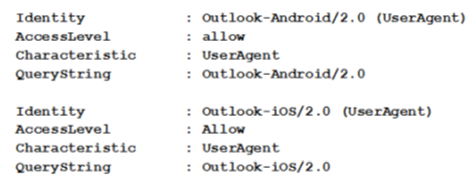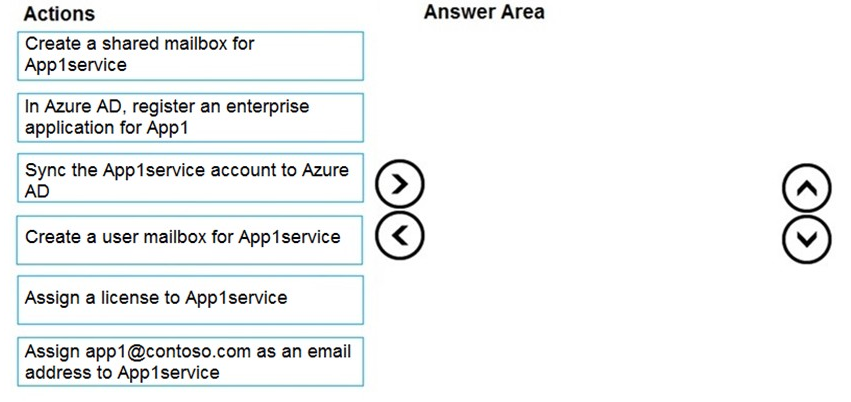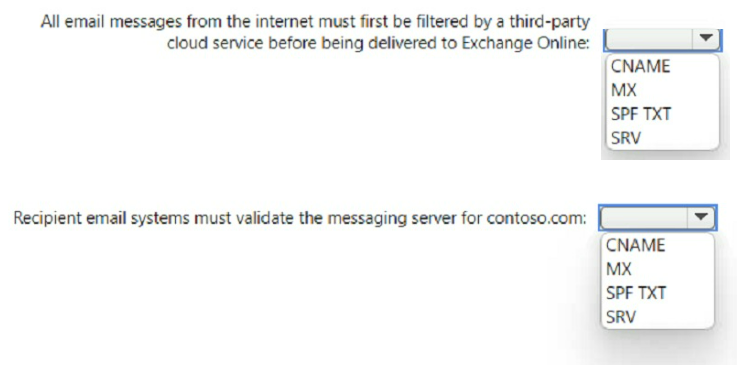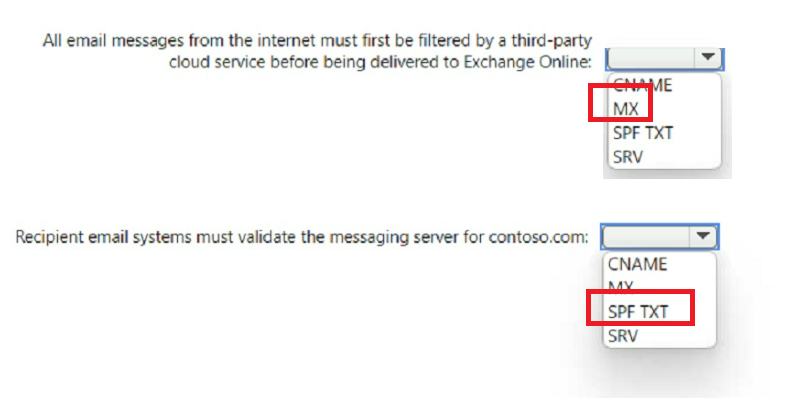Microsoft MS-203 - Microsoft 365 Messaging
: 243
Note: This question is part of a series of questions that present the same scenario. Each question in the series contains a unique solution that might meet the stated goals. Some question sets might have more than one correct solution, while others might not have a correct solution.
After you answer a question in this section, you will NOT be able to return to it. As a result, these questions will not appear in the review screen.
You have a Microsoft Exchange Online tenant that contains 1,000 users.
A user named User1 receives a non-delivery report (NDR) when attempting to send an email message to an internal group named sales@contoso.com. The NDR contains the following text: “5.7.1 Delivery not authorized.â€
You need to ensure that User1 can send email to sales@contoso.com successfully.
Solution: You modify the properties of a mail flow rule
NO: 8 HOTSPOT
You have a Microsoft Exchange Online subscription.
You run the following command.
Set-ActiveSyncOrganizationSettings –DefaultAccessLevel Block
You run Get-ActiveSyncDeviceAccessRule | f1 Identity, AccessLevel, Characteristic, QueryString and you receive the following output.

For each of the following statements, select Yes if the statement is true. Otherwise, select No.
NOTE: Each correct selection is worth one point.

Your network contains an Active Directory domain and an Azure Active Directory (Azure AD) tenant in a hybrid deployment.
You implement a Microsoft Exchange Online tenant.
You plan to deploy a new on-premises app named App1 to a Windows server. The solution must meet the following requirements:
Use an Active Directory user account named App1service as a service account.
Be able to receive email requests by using an email address of app1@contoso.com.
Use App1service to sign in to the mailbox of App1 to view the requests.
In the domain, you create App1service.
Which three actions should you perform in sequence? To answer, move the appropriate actions from the list of actions to the answer area and arrange them in the correct order.

You have a Microsoft Exchange Server 2019 organization.
You purchase a Microsoft 365 subscription and configure Active Directory synchronization.
You use a smart host for all email communication between the organization and the Internet. The smart host performs email hygiene and alerts message headers.
You plan to run the Hybrid Configuration wizard to create an Exchange hybrid deployment and change the MX record to point to Exchange Online.
You need to decommission the smart host from the organization.
What should you do first?
You have a Microsoft Exchange Online tenant.
You need to add a custom domain named contoso.com that meets the following requirements:
« All email messages from the intemet must first be filtered by a third-party cloud service before being delivered to Exchange Online.
« Recipient email systems must validate the messaging server for contoso.com)
Which type of DNS record should you use for each requirement? To answer, select the appropriate options in the answer area.
NOTE: Each correct selection is worth one point.

You have a Microsoft Exchange Server 2019 organization.
A compliance manager plans to create retention policies for the mailboxes of executive users. The policies will move specific emails to an archive mailbox.
You need to create an archive mailbox for each executive user.
What should you do?
You have a Microsoft Exchange Online tenant.
You need to import PST files from a legacy archiving solution to Exchange Online. You will import the PST files over the internet.
Which five actions should you perform in sequence? To answer, move the appropriate actions from the list of actions to the answer area and arrange them in the correct order.

You have a Microsoft Exchange Server 2019 hybrid deployment that contains the public folders shown in the following table.

You plan to migrate the public folders to Exchange Online to improve the collaboration options available to users.
Which public folders can be migrated to Office 365 groups without losing the folders’ existing functionality?
Your company has a partnership with another company named contoso.com.
You need to ensure that all email messages containing the word sensitive and sent to the users at contoso.com are encrypted automatically.
You enable Azure Information Protection.
What should you do next?
You have a Microsoft Exchange Online tenant.
Two users named User1 and User2 have left the company and have inactive mailboxes.
Two new employees named User3 and User4 are hired and must meet the following requirements:
• User3 has the same job role as User1 and requires access to all the items in the User1 mailbox.
• User4 was hired to replace User2 and requires access to the User2 mailbox.
You need to recommend a solution fw User3 and User4 to access the inactive mailboxes. The solution must minimize administrative effort.
What should you recommend for each user? To answer, drag the appropriate solutions to the correct users. Each solution may be used once, more than once, or not at all. You may need to drag the split bar between panes or scroll to view content.






 Graphical user interface, text, application, chat or text message
Description automatically generated
Graphical user interface, text, application, chat or text message
Description automatically generated



